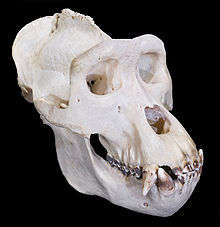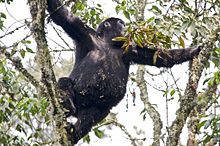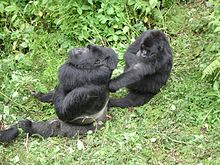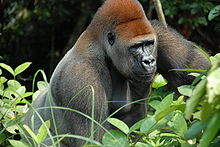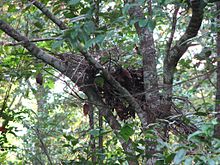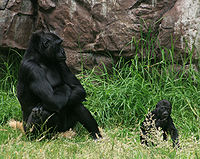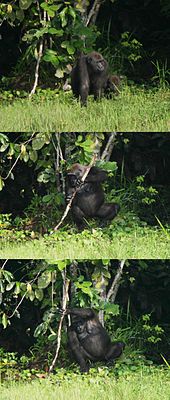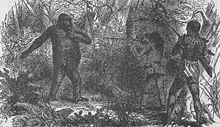- Gorilla
-
"Blackback" and "Silverback" redirect here. For other uses, see Blackback (disambiguation) and Silverback (disambiguation).
Gorillas[1] 
Western gorilla
(Gorilla gorilla)Scientific classification Kingdom: Animalia Phylum: Chordata Class: Mammalia Order: Primates Family: Hominidae Subfamily: Homininae Tribe: Gorillini Genus: Gorilla
I. Geoffroy, 1852Type species Troglodytes gorilla
Savage, 1847Species 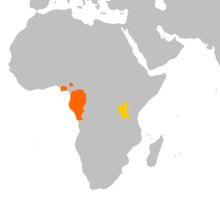
Distribution of gorillas Synonyms - Pseudogorilla Elliot, 1913
Gorillas are the largest extant species of primates. They are ground-dwelling, predominantly herbivorous apes that inhabit the forests of central Africa. Gorillas are divided into two species and either four or five subspecies. The DNA of gorillas is highly similar to that of a human, from 95–99% depending on what is counted,[2] and they are the next closest living relatives to humans after the two chimpanzee species.
Gorillas' natural habitats cover tropical or subtropical forests in Africa. Although their range covers a small percentage of Africa, gorillas cover a wide range of elevations. The mountain gorilla inhabits the Albertine Rift montane cloud forests of the Virunga Volcanoes, ranging in altitude from 2,200–4,300 metres (7,200–14,100 ft). Lowland Gorillas live in dense forests and lowland swamps and marshes as low as sea level, with western lowland gorillas living in Central West African countries and eastern lowland gorillas living in the Democratic Republic of the Congo near its border with Rwanda.[3]
Contents
Etymology
The American physician and missionary Thomas Staughton Savage and naturalist Jeffries Wyman first described the Western Gorilla (they called it Troglodytes gorilla) in 1847 from specimens obtained in Liberia.[4] The name was derived from the Greek word "Γόριλλαι" (Gorillai), a "tribe of hairy women"[5] described by Hanno the Navigator, a Carthaginian navigator and possible visitor (circa 480 BC) to the area that later became Sierra Leone.[6]
Evolution and classification
The closest relatives of gorillas are chimpanzees and humans, all of the Hominidae having diverged from a common ancestor about 7 million years ago.[7] Human genes differ only 1.6% on average from their corresponding gorilla genes in their sequence, but there is further difference in how many copies each gene has.[8] Richard Dawkins in his book “The ancestor’s tale” 2004 Boston: Houghton Mifflin Eds, proposes that gorillas are descended from Australopithecus Robustus (parnthropus) type species. For instance Paranthropus aethiopicus has characteristic gorilla-like crests on its skull (see Homininae). In other words the ancestors of gorillas are Paranthropus. Until recently there was considered to be a single gorilla species, with three subspecies: the western lowland gorilla, the eastern lowland gorilla and the mountain gorilla.[9][10] There is now agreement that there are two species with two subspecies each. More recently it has been claimed that a third subspecies exists in one of the species. The separate species and subspecies developed from a single type of gorilla during the Ice Age, when their forest habitats shrank and became isolated from each other.[3]
Primatologists continue to explore the relationships between various gorilla populations.[9] The species and subspecies listed here are the ones upon which most scientists agree.[citation needed]
- Genus Gorilla [1]
- Western Gorilla (Gorilla gorilla)
- Western Lowland Gorilla (Gorilla gorilla gorilla)
- Cross River Gorilla (Gorilla gorilla diehli)
- Eastern Gorilla (Gorilla beringei)
- Mountain Gorilla (Gorilla beringei beringei)
- Eastern Lowland Gorilla (Gorilla beringei graueri)
- Western Gorilla (Gorilla gorilla)
The proposed third subspecies of Gorilla beringei, which has not yet received a trinomen, is the Bwindi population of the mountain gorilla, sometimes called the Bwindi gorilla.
Some variations that distinguish the classifications of gorilla include varying density, size, hair color, length, culture, and facial widths.[3] There are now thought to be over 100,000 western lowland gorillas in the wild, with 4,000 in zoos; eastern lowland gorillas have a population of 4,000 in the wild and 24 in zoos.[3] Mountain gorillas are the most severely endangered, with an estimated population of about 620 left in the wild and none in zoos.[3]
Physical characteristics
Gorillas move around by knuckle-walking, although they sometimes walk bipedally for short distances while carrying food or in defensive situations.[11] Adult males, also called silverbacks, range in height 1.65–1.75 metres (5 ft 5 in–5 ft 9 in), and in weight 140–200 kg (310–440 lb). Adult females are often half the size of a silverback, averaging about 1.4 metres (4 ft 7 in) tall and 100 kg (220 lb). Occasionally, a silverback of over 1.8 metres (5 ft 11 in) and 230 kg (510 lb) has been recorded in the wild. Obese gorillas in captivity have reached a weight of 270 kg (600 lb).[12] Gorillas have a facial structure which is described as mandibular prognathism, that is, their mandible protrudes farther out than the maxilla. Adult males also have a prominent sagittal crest.
The eastern gorilla is more darkly colored than the western gorilla, with the mountain gorilla being the darkest of all. The mountain gorilla also has the thickest hair. The western lowland gorilla can be brown or grayish with a reddish forehead. In addition, gorillas that live in lowland forests are more slender and agile than the more bulky mountain gorilla. The eastern gorilla also has a longer face and broader chest than the western gorilla.[13]
Almost all gorillas share the same blood type (B)[14][unreliable source?] and, like humans, have individual finger prints.[15][16] Their eye color is dark brown, framed by a black ring around the iris.
Behavior and ecology
Range and habitat
Gorillas have a patchy distribution. The range of the two species is separated by the Congo river and its tributaries. The western gorilla lives in west central Africa while the eastern gorilla lives in east central Africa. Between the species and even within the species, gorillas live in a variety of habitats and elevations. Gorilla habitat ranges from montane forests to swamps. Eastern gorilla live in montane and submontane forests ranging 650–4000 m (2132-13,123 ft).[17] Mountain gorillas live in the montane forests at the higher ends of the elevation range while eastern lowland gorillas live in submotane forests at the lower ends of the elevation range. In addition, eastern lowland gorillas live in montane bamboo forests as well as lowland forests ranging from 600–3308 m (1969-10,853 ft) in elevation.[18] Western gorillas live in both lowland swamp forests and montane forests and live in elevations ranging from sea level to 1600 m (5249 ft).[17] Western lowland gorillas live in swamp and lowland forests ranging up to 1600 m (5249 ft) and Cross River gorillas live in low-lying and submontane forests ranging 150–1600 m (492–5249 ft).
Food and foraging
Gorillas have synchronized activities. During the day they have rest periods and travel or feeding periods. There are dietary differences between and within the species. Mountain gorillas mostly eat foliage such as leaves, stems, pith, and shoots of terrestrial herbaceous vegetation. High quality, high protein, low fiber, and low tannin foods from certain species are preferred and fruit makes a very small part of their diet.[19] Bamboo is also a favored food item and gorilla will spend much time digging to unearth the tender shoots. Little competition exists between mountain gorilla groups for resources since they rely on food that is readily available and easily accessed. They have small home ranges that range 3–15 km² (1.16–5.79 mi²), and they move only 500 m (.311 mi) or less on an average day.[19] Despite eating a few species in each habitat, mountain gorillas have a flexible diet and can occupy a wide variety of habitats in their range.[19]
Lowland gorillas have a more diverse diet. The diet of the eastern lowland gorilla varies seasonally. Leaves and pith are staples of their diet but they also eat fruits when they are available and fruits can make as much as 25% of their diet. Since fruit is relatively scarce, gorillas most travel farther a day and have home ranges that vary from 2.7–6.5 km² (1.04 to 2.51 mi²) with day ranges 154–2280 m (0.096–1.42 mi). Eastern lowland gorillas will also eat insects, preferably ants.[20] Western lowland gorillas do not have much access to high quality terrestrial herbs, although some areas in their range are rich in aquatic herbs. These gorillas depend on fruits more than the others and they are more dispersed across their range.[21] As such, western lowland gorilla travel the farthest of the gorillas and have the largest home ranges. They travel per 1105 m (.687 mi) per day on average and have home ranges 7–14 km² (2.70–5.41 mi²).[21] Termites and ants also make a staple of the western lowland gorilla’s diet.
Gorillas rarely drink water "because they consume succulent vegetation that is comprised of almost half water as well as morning dew",[22] although both mountain and lowland gorillas have been observed drinking.
One possible predator of gorillas is the leopard. Gorilla remains have been found in leopard scat but it is possible that this may be the result of scavenging.[23] When the group is attacked by humans, leopards, or other gorillas, the silverback will protect them even at the cost of his own life.[24] George Schaller reported that a silverback gorilla and a leopard were both found dead from mutually inflicted wounds.[25]
Social structure
Gorillas live in groups called troops. Troops tend to be made of one adult male or silverback, multiple adult females and their offspring.[26][27][28] However, multi-male troops also exist.[27] Silverbacks are typically more than 12 years of age and named for the distinctive patch of silver hair on their back which comes with maturity. They also have large canine teeth which also come with maturity. Both males and females tend to emigrate from their natal groups. For mountain gorillas, females disperse from their natal troops more than males.[26][29] Mountain gorillas and western lowland gorillas also commonly transfer to second new groups.[26] Mature males tend to also leave their groups and establish their own troops by attracting emigrating females. However, male mountain gorillas sometimes stay in their natal troops and become subordinate to the silverback. If the silverback dies, these males may be able to become dominant or mate with the females. This behavior has not been observed in eastern lowland gorillas. In a single male group, when the silverback dies, the females and their offspring disperse and find a new troop.[29][30] Without a silverback to protect them, the infants will likely fall victim to infanticide. Joining a new group is likely to be a tactic against this.[29][31] However while gorilla troops usually disband after the silverback dies, female eastern lowlands gorillas and their offspring have been recorded staying together until a new silverback transfers into the group. This likely serves as protection from leopards.[30] All male troops have also been recorded.
The silverback is the center of the troop's attention, making all the decisions, mediating conflicts, determining the movements of the group, leading the others to feeding sites and taking responsibility for the safety and well-being of the troop. Younger males subordinate to the silverback, known as blackbacks, may serve as backup protection. Blackbacks are aged between 8 and 12 years of age[28] and lack the silver back hair. The bond a silverback has with his females forms the core of gorilla social life. Bonds between them are maintained by grooming and close proximity.[32] Having strong relationships with males is important for females as males give them mating opportunities and protection from predators and infanticidal outside males.[33] However aggressive behaviors between males and females are common although they rarely lead to serious injury. Relationships between females may vary. Maternally related females in a troop associate closely and tend to have friendly interactions. Otherwise, females usually have little friendly interactions and commonly act aggressive towards each other.[26] Aggressive interactions between females tend to be centered around social access to males with males intervening in fights between females.[32] Male gorillas have weak social bonds, particularly in multi-male groups with apparent dominance hierarchies and strong competition for mates. However, males in all-male groups tend to have friendly interactions and socialize through play, grooming and close proximity,[28] and occasionally they even engage in homosexual interactions.[34]
Nesting
Gorillas construct nests for daytime and night use. Day nests tend to be simple aggregations of branches and leaves on the ground while night nests are more elaborate constructions in trees. The nests may be 2 to 5 feet (0.61 to 1.5 m) in diameter and are constructed by individuals. The young nest with the mother but construct nests after three years of age, initially close to that of their mother.[35] Gorilla nests are distributed arbitrarily and use of tree species for site and construction appears to be opportunistic.[36] Nest building by great apes is now considered to be not just animal architecture but as an important instance of tool use.[36]
Reproduction and parenting
A female’s first ovulatory cycle occurs when she is six years of age and is followed by a two year long period of adolescent infertility.[37] The estrous cycle last 30–33 days with outward ovulation signs subtle compared to that of chimpanzees. The gestation period lasts 8.5 months. Female mountain gorillas first give birth at 10 years of age and have four year interbirth intervals.[37] Males can be fertile before reaching adulthood. Gorillas mate year round.[38] Females incite copulation by pursing their lips and slowly approaching a male while establishing prolonged eye contact. If the male does not respond, then she will try to attract his attention by reaching towards him or slapping the ground.[39] In multi-male groups, solicitation indicates female preference. However females can be coerced to mate with multiple males.[39] Males incite copulation by approaching a female and displaying at her or touching her and giving a "train grunt".[38] Recently, gorillas have been observed engaging in face-to-face sex, a trait that was once considered unique to humans and the bonobo.[40]
Gorilla infants are vulnerable and dependant and thus mothers, their primary caregivers, are important to their survival.[31] Gorilla mothers invest years caring for their offspring. Male gorillas are not active in caring for the young. However they do play a role in socializing them as they will associate with older infants and juveniles.[41] The silverback has a largely supportive relationship with the infants in his troop. He will shield them from intragroup aggression.[41] Infants remain in contact with their mothers for the first five months and mothers stay near the silverback for protection.[41] Infants will suckle at least once per hour and will sleep with their mothers in the same nest.[42] Infants begin to break contact with their mothers after five months but only for brief period each time. By 12 months, infants venture up to five meters (16.4 ft) from their mothers. At around 18–21 months, the distance between mother and offspring increases and they regularly spend time away from each other.[43] In addition, nursing decreases to once every two hours.[42] Infants spend only half of their time with their mothers by 30 months. Gorillas enter their juvenile period at their third year and this lasts until their sixth year. At this time, gorillas are weaned and they sleep in a separate nest from their mothers.[41] After their offspring are weaned, females begin to ovulate and soon become pregnant again.[41][42] Conflicts in weaning between mother and offspring is minimized as the young has many play partners including the silverback.[43] Females mature at 10–12 years (earlier in captivity); males at 11–13 years. Lifespan is between 30–50 years, although there have been exceptions. For example the Dallas Zoo's Jenny lived to the age of 55.[44][45][46]
Communication
Twenty-five distinct vocalizations are recognized, many of which are used primarily for group communication within dense vegetation. Sounds classified as grunts and barks are heard most frequently while traveling, and indicate the whereabouts of individual group members.[47] They may also be used during social interactions when discipline is required. Screams and roars signal alarm or warning, and are produced most often by silverbacks. Deep, rumbling belches suggest contentment and are heard frequently during feeding and resting periods. They are the most common form of intragroup communication.[48] Severe aggression is rare in stable groups, but when two mountain gorilla groups meet, the two silverbacks can sometimes engage in a fight to the death, using their canines to cause deep, gaping injuries.[48] The entire sequence has nine steps: (1) progressively quickening hooting, (2) symbolic feeding, (3) rising bipedally, (4) throwing vegetation, (5) chest-beating with cupped hands, (6) one leg kick, (7) sideways running, two-legged to four-legged, (8) slapping and tearing vegetation, and (9) thumping the ground with palms to end display.[49]
Intelligence
Gorillas are considered[by whom?] highly intelligent. A few individuals in captivity, such as Koko, have been taught a subset of sign language (see animal language for a discussion). Like the other great apes, gorillas can laugh, grieve, have "rich emotional lives," develop strong family bonds, can make and use tools, and can think about the past and future.[50] Some researchers believe that gorillas have spiritual feelings or religious sentiments.[3] Gorillas have been shown to have cultures in different areas revolving around different methods of food preparation, and gorillas will show individual color preferences.[3]
Tool use
The following observations were made by a team led by Thomas Breuer of the Wildlife Conservation Society in September 2005. Gorillas are now known to use tools in the wild. A female gorilla in the Nouabalé-Ndoki National Park in the Republic of Congo was recorded using a stick as if to gauge the depth of water whilst crossing a swamp. A second female was seen using a tree stump as a bridge and also as a support whilst fishing in the swamp. This means that all of the great apes are now known to use tools.[51]
In September 2005, a two and a half year old gorilla in the Republic of Congo was discovered using rocks to smash open palm nuts inside a game sanctuary.[52] While this was the first such observation for a gorilla, over 40 years previously chimpanzees had been seen using tools in the wild, famously 'fishing' for termites. Great apes are endowed with a semi-precision grip, and certainly have been able to use both simple tools and even weapons, by improvising a club from a convenient fallen branch.
Interactions with humans
Studies
The word "gorilla" comes from the history of Hanno the Navigator, a Carthaginian explorer on an expedition on the west African coast. They encountered "a savage people, the greater part of whom were women, whose bodies were hairy, and who our interpreters called Gorillae".[53] The word was then later used as the species name, though it is unknown whether what these ancient Carthaginians encountered were truly gorillas, another species of ape or monkeys, or humans.[9]
American physician and missionary Thomas Staughton Savage obtained the first specimens (the skull and other bones) during his time in Liberia in Africa.[4] The first scientific description of gorillas dates back to an article by Savage and the naturalist Jeffries Wyman in 1847 in Proceedings of the Boston Society of Natural History,[54][55] where Troglodytes gorilla is described, now known as the Western Gorilla. Other species of gorilla are described in the next couple of years.[9]
Explorer Paul du Chaillu was the first westerner to see a live gorilla during his travel through western equatorial Africa from 1856 to 1859. He brought dead specimens to the UK in 1861.[56][57]
The first systematic study was not conducted until the 1920s, when Carl Akeley of the American Museum of Natural History traveled to Africa to hunt for an animal to be shot and stuffed. On his first trip he was accompanied by his friends Mary Bradley, a famous mystery writer, and her husband. After their trip, Mary Bradley wrote On the Gorilla Trail. She later became an advocate for the conservation of gorillas and wrote several more books (mainly for children). In the late 1920s and early 1930s, Robert Yerkes and his wife Ava helped further the study of gorillas when they sent Harold Bigham to Africa. Yerkes also wrote a book in 1929 about the great apes.
After World War II, George Schaller was one of the first researchers to go into the field and study primates. In 1959, he conducted a systematic study of the mountain gorilla in the wild and published his work. Years later, at the behest of Louis Leakey and the National Geographic, Dian Fossey conducted a much longer and more comprehensive study of the Mountain Gorilla. It was not until she published her work that many misconceptions and myths about gorillas were finally disproved, including the myth that gorillas are violent.
Endangerment
Both species of gorilla are endangered,[58] and have been subject to intense poaching for a long time. Threats to gorilla survival include habitat destruction and the bushmeat trade. In 2004, a population of several hundred gorillas in the Odzala National Park, Republic of Congo was essentially wiped out by the Ebola virus.[59] A 2006 study published in Science concluded that more than 5,000 gorillas may have died in recent outbreaks of the Ebola virus in central Africa. The researchers indicated that in conjunction with commercial hunting of these apes, the virus creates "a recipe for rapid ecological extinction."[60] Conservation efforts include the Great Ape Survival Project, a partnership between the United Nations Environment Programme and the UNESCO, and also an international treaty, the Agreement on the Conservation of Gorillas and Their Habitats, concluded under UNEP-administered Convention on Migratory Species. The Gorilla Agreement is the first legally binding instrument exclusively targeting Gorilla conservation and came into effect on 1 June 2008.
Cultural references
Since they came to the attention of western society in the 1860s, gorillas have been a recurring element of many aspects of popular culture and media. For example, gorillas have featured prominently in monstrous fantasy films such as King Kong, and pulp fiction such as the stories of Tarzan and Conan the Barbarian have featured gorillas as physical opponents to the titular protagonists.
See also
- List of apes – notable individual apes
- List of fictional apes
- Bili ape
References
- ^ a b Groves, C. (2005). Wilson, D. E., & Reeder, D. M, eds. ed. Mammal Species of the World (3rd ed.). Baltimore: Johns Hopkins University Press. pp. 181–182. OCLC 62265494. ISBN 0-801-88221-4. http://www.bucknell.edu/msw3/browse.asp?id=12100787.
- ^ Greater Than 98% Chimp/Human DNA Similarity? Not Any More.. Answers in Genesis (2003-04-01). Retrieved on 2011-09-27.
- ^ a b c d e f g Prince-Hughes, Dawn (1987). Songs of the Gorilla Nation. Harmony. p. 66. ISBN 1400050588.
- ^ a b Conniff R. Discovering gorilla. Evolutionary Anthropology, 18: 55–61. doi:10.1002/evan.20203
- ^ Γόριλλαι, Henry George Liddell, Robert Scott, A Greek-English Lexicon, on Perseus Digital Library
- ^ Müller, C. (1855–61). Geographici Graeci Minores. pp. 1.1–14: text and trans. Ed, J. Blomqvist (1979).
- ^ Glazko GV, Nei M (March 2003). "Estimation of divergence times for major lineages of primate species". Mol. Biol. Evol. 20 (3): 424–34. doi:10.1093/molbev/msg050. PMID 12644563. http://mbe.oxfordjournals.org/cgi/content/full/20/3/424.
- ^ Goidts V, Armengol L, Schempp W et al. (March 2006). "Identification of large-scale human-specific copy number differences by inter-species array comparative genomic hybridization". Hum. Genet. 119 (1–2): 185–98. doi:10.1007/s00439-005-0130-9. PMID 16395594.
- ^ a b c d Groves, Colin (2002). "A history of gorilla taxonomy". Gorilla Biology: A Multidisciplinary Perspective, Andrea B. Taylor & Michele L. Goldsmith (editors) (Cambridge University Press): 15–34. doi:10.2277/0521792819. http://arts.anu.edu.au/grovco/Gorilla%20Biology.pdf.
- ^ Stewart, Kelly J.; Pascale Sicotte, Martha M. Robbins (2001). "Mountain Gorillas of the Virungas". Fathom / Cambridge University Press. http://www.fathom.com/course/21701783/. Retrieved 2008-09-11.
- ^ Prince-Hughes, Dawn (1987). Songs of the Gorilla Nation. Harmony. pp. 82–3. ISBN 1400050588.
- ^ "Gorilla – The Columbia Encyclopedia, Sixth Edition". bartleby.com. Archived from the original on 2008-02-12. http://web.archive.org/web/20080212005936/http://www.bartleby.com/65/go/gorilla.html. Retrieved 2006-10-10.
- ^ Rowe N. (1996) Pictorial guide to the living primates. East Hampton (NY): Pogonias Pr.
- ^ Glass, Bonnie B. (2001). "Evolution of the Human". http://facstaff.uwa.edu/jmccall/evolution_of_the_human.htm. Retrieved 2007-10-22.
- ^ "Santa Barbara Zoo – Western Lowland Gorilla". santabarbarazoo.org. http://www.santabarbarazoo.org/showAnimals.asp?id=149. Retrieved 2006-10-10.
- ^ http://nationalzoo.si.edu/Animals/Primates/Facts/FactSheets/Gorillas/default.cfm
- ^ a b Sarmiento EE. (2003) "Distribution, taxonomy, genetics, ecology, and causal links of gorilla survival: the need to develop practical knowledge for gorilla conservation". In: Taylor AB, Goldsmith ML, editors. Gorilla biology: a multidisciplinary perspective. Cambridge (England): Cambridge Univ Pr. pp. 432–71.
- ^ Ilambu O. (2001) "Ecology of Eastern Lowland gorilla: is there enough scientific knowledge to mitigate conservation threats associated with extreme disturbances in its distribution range?" In: The apes: challenges for the 21st century. Conference proceedings; 2000 May 10–13; Brookfield, IL. Chicago: Chicago Zoo Soc. pp. 307–12.
- ^ a b c McNeilage A. (2001) "Diet and habitat use of two mountain gorilla groups in contrasting habitats in the Virungas". In: Robbins MM, Sicotte P, Stewart KJ, editors. Mountain gorillas: three decades of research at Karisoke. Cambridge (England): Cambridge University Press. p 265-92.
- ^ Yamagiwa J, Mwanza N, Yumoto T, Maruhashi T. (1994). "Seasonal change in the composition of the diet of eastern lowland gorillas". Primates 35: 1. doi:10.1007/BF02381481.
- ^ a b Tutin CG. (1996) "Ranging and social structure of lowland gorillas in the Lopé Reserve, Gabon". In: McGrew WC, Marchant LF, Nishida T, editors. Great ape societies. Cambridge (England): Cambridge Univ Pr. pp. 58–70.
- ^ GORILLAS – Diet & Eating Habits. Seaworld.org. Retrieved on 2011-09-27.
- ^ Fay JM, Carroll R, Kerbis Peterhans JC, Harris D. (1995). "Leopard attack on and consumption of gorillas in the Central African Republic". Journal of Human Evolution 29 (1): 93–9. doi:10.1006/jhev.1995.1048. http://www.catsg.org/catsglib/recordetail.php?recordid=5654.
- ^ Wildlife: Mountain Gorilla. AWF. Retrieved on 2011-09-27.
- ^ Making a Last Stand Counterattack and Chutzpah Living Primates. Intechinc.com (2011-08-19). Retrieved on 2011-09-27.
- ^ a b c d Watts DP. (1996) "Comparative socio-ecology of gorillas". In: McGrew WC, Marchant LF, Nishida T, editors. Great ape societies. Cambridge (England): Cambridge Univ Pr. p 16-28.
- ^ a b Yamagiwa J, Kahekwa J, Kanyunyi Basabose A. (2003). "Intra-specific variation in social organization of gorillas: implications for their social evolution". Primates 44 (4): 359–69. doi:10.1007/s10329-003-0049-5. PMID 12942370.
- ^ a b c Robbins MM. (2001) "Variation in the social system of mountain gorillas: the male perspective". In: Robbins MM, Sicotte P, Stewart KJ, editors. Mountain gorillas: three decades of research at Karisoke. Cambridge (England): Cambridge Univ Pr. pp. 29–58.
- ^ a b c Stokes EJ, Parnell RJ, Olejniczak C. (2003). "Female dispersal and reproductive success in wild western lowland gorillas (Gorilla gorilla gorilla)". Behav Ecol Sociobiol 54 (4): 329–39. doi:10.1007/s00265-003-0630-3. JSTOR 25063274.
- ^ a b Yamagiwa J, Kahekwa J. (2001) "Dispersal patterns, group structure, and reproductive parameters of eastern lowland gorillas at Kahuzi in the absence of infanticide". In: Robbins MM, Sicotte P, Stewart KJ, editors. Mountain gorillas: three decades of research at Karisoke. Cambridge (England): Cambridge Univ Pr. pp. 89–122.
- ^ a b Watts DP. (1989). "Infanticide in mountain gorillas: new cases and a reconsideration of the evidence". Ethology 81: 1–18. doi:10.1111/j.1439-0310.1989.tb00754.x.
- ^ a b Watts DP. (2003) "Gorilla social relationships: a comparative review". In: Taylor AB, Goldsmith ML, editors. Gorilla biology: a multidisciplinary perspective. Cambridge (England): Cambridge Univ Pr. pp. 302–27.
- ^ Watts DP. (2001) "Social relationships of female mountain gorillas". In: Robbins MM, Sicotte P, Stewart KJ, editors. Mountain gorillas: three decades of research at Karisoke. Cambridge (England): Cambridge Univ Pr. pp. 216–40.
- ^ Juichi Yamagiwa (1987). "Intra- and Inter-group Interactions of an All-male Group of Virunga Mountain Gorillas (Gorilla gorilla beringei )". Primates 28 (1): 1–30. doi:10.1007/BF02382180.
- ^ Miller-Schroeder, Patricia (1997). Gorillas. Weigl Educational Publishers. p. 20. ISBN 9780919879898. http://books.google.com/books?id=wSXgVKUYpvgC&pg=PA20. Retrieved 4 July 2011.
- ^ a b Marchant, Linda Frances; Nishida, Toshisada (1996). Great ape societies. Cambridge University Press. pp. 226–227. ISBN 9780521555364. http://books.google.com/books?id=iGfjJ4lKb1IC&pg=PA226. Retrieved 4 July 2011.
- ^ a b Czekala N, Robbins MM. (2001) "Assessment of reproduction and stress through hormone analysis in gorillas". In: Robbins MM, Sicotte P, Stewart KJ, editors. Mountain gorillas: three decades of research at Karisoke. Cambridge (England): Cambridge Univ Pr. pp. 317–39.
- ^ a b Watts DP (1991). "Mountain gorilla reproduction and sexual behavior". Am J Primatol 24 (3–4): 211. doi:10.1002/ajp.1350240307.
- ^ a b Sicotte P. (2001) "Female mate choice in mountain gorillas". In: Robbins MM, Sicotte P, Stewart KJ, editors. Mountain gorillas: three decades of research at Karisoke. Cambridge (England): Cambridge Univ Pr. pp. 59–87.
- ^ Tuan C. Nguyen. "Caught in the act! Gorillas mate face to face". MSN. http://www.msnbc.msn.com/id/23148063.
- ^ a b c d e Stewart KJ. (2001) "Social relationships of immature gorillas and silverbacks". In: Robbins MM, Sicotte P, Stewart KJ, editors. Mountain gorillas: three decades of research at Karisoke. Cambridge (England): Cambridge Univ Pr. pp. 183–213.
- ^ a b c Stewart KJ (1988). "Suckling and lactational anoestrus in wild gorillas (Gorilla gorilla)". J Reprod Fertil 83 (2): 627–34. PMID 3411555.
- ^ a b Fletcher A. (2001) "Development of infant independence from the mother in wild mountain gorillas". In: Robbins MM, Sicotte P, Stewart KJ, editors. Mountain gorillas: three decades of research at Karisoke. Cambridge (England): Cambridge University Press. pp. 153–82.
- ^ World's oldest gorilla celebrates 55th birthday. 3news.co.nz. 9 May 2009
- ^ Gorilla celebrates 55th birthday with frozen cake. Gmanews.tv. Retrieved on 2011-09-27.
- ^ Associated Press, Oldest living gorilla dies at 55. 6 September 2008.
- ^ Harcourt, A.H., Stewart, K.J., Hauser, M. (1993). "Functions of wild gorilla 'close' calls. I. Repertoire, context, and interspecific comparison". Behaviour 124: 89. doi:10.1163/156853993X00524.
- ^ a b Fossey, D. (1983). Gorillas in the mist. Boston: Houghton Mifflin Company. ISBN 0395282179.
- ^ Maple, T.L., & Hoff, M.P. (1982). Gorilla Behavior. New York: Van Nostrand Reinhold Company.
- ^ Planet Of No Apes? Experts Warn It's Close CBS News Online, 2007-09-12. Retrieved 2008-03-22.
- ^ Breuer T, Ndoundou-Hockemba M, Fishlock V (2005). "First Observation of Tool Use in Wild Gorillas". PLoS Biol 3 (11): e380. doi:10.1371/journal.pbio.0030380. PMC 1236726. PMID 16187795. http://www.pubmedcentral.nih.gov/articlerender.fcgi?tool=pmcentrez&artid=1236726.
- ^ "A Tough Nut To Crack For Evolution". CBS News. 2005-10-18. http://www.cbsnews.com/stories/2005/10/18/tech/main951800.shtml. Retrieved 2006-10-18.
- ^ Periplus of Hanno, final paragraph. Shsu.edu. Retrieved on 2011-09-27.
- ^ Savage TS. (1847). Communication describing the external character and habits of a new species of Troglodytes (T. gorilla). Boston Soc Nat Hist: 245–247.
- ^ Savage TS, Wyman J. (1847). Notice of the external characters and habits of Troglodytes gorilla, a new species of orang from the Gaboon River, osteology of the same. Boston J Nat Hist 5:417–443.
- ^ McCook, S. (1996). ""It May Be Truth, but It Is Not Evidence": Paul du Chaillu and the Legitimation of Evidence in the Field Sciences". Osiris 11: 177–197. doi:10.1086/368759.
- ^ A History of Museum Victoria: Melbourne 1865: Gorillas at the Museum. Museumvictoria.com.au. Retrieved on 2011-09-27.
- ^ IUCN Gorilla listing. Iucnredlist.org. Retrieved on 2011-09-27.
- ^ "Gorillas infecting each other with Ebola". NewScientist.com. 2006-07-10. http://www.newscientist.com/article/dn9517-gorillas-infecting-each-other-with-ebola.html. Retrieved 2006-07-10.
- ^ "Ebola 'kills over 5,000 gorillas'". News.bbc.co.uk. 2006-12-08. http://news.bbc.co.uk/2/hi/science/nature/6220122.stm. Retrieved 2006-12-09.
External links
- Animal Diversity Web – includes photos, artwork, and skull specimens of Gorilla gorilla
- Pulitzer Center on Crisis Reporting International Gorilla Conservation Programme (Video)
- Primate Info Net Gorilla Factsheet – taxonomy, ecology, behavior and conservation
- San Diego Zoo Gorilla Factsheet – features a video and photos
- World Wildlife Fund: Gorillas – conservation, facts and photos
- Gorilla protection – Gorilla conservation
- Welcome to the Year of the Gorilla 2009
- Virunga National Park – The Official Website for Virunga National Park, the Last Refuge for Congo's Mountain Gorillas.
Extant species of family Hominidae (Great apes) Kingdom: Animalia · Phylum: Chordata · Class: Mammalia · Order: Primates · Suborder: Haplorrhini Ponginae Homininae GorillaCategory Ape-related articles Ape species 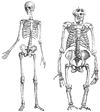
Ape study Ape language · Ape Trust · Dian Fossey · Birutė Galdikas · Jane Goodall · Chimpanzee genome project · Human genome project · Neanderthal genome project · Willie Smits · Lone Drøscher Nielsen · Borneo Orangutan SurvivalLegal and social status See also Bushmeat · Ape extinction · List of notable apes · List of fictional apes · Human evolution · Mythic humanoids · HominidCategories:- Apes
- Gorillas
- Mammals of Africa
- Megafauna of Africa
- Herbivorous animals
- Greek loanwords
Wikimedia Foundation. 2010.

